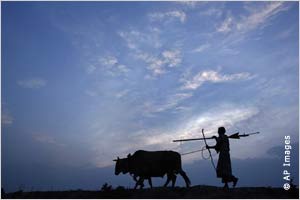High Prices Threaten Food Security
High Prices Threaten Food Security
17 June 2011

An Indian farmer drives his oxen after a day in the fields. India saw a double-digit surge in food costs in 2010, a burden to many poor people.
The outlook for world agricultural output and food supplies is positive in the near future, but several years out, the Agricultural Outlook 2011–2020 report projects higher prices and persistent volatility in commodity supplies and prices.
Released June 17 by the Organisation for Economic Co-operation and Development (OECD) and the U.N. Food and Agriculture Organization (FAO), the report says that a good harvest this season will translate into lower prices on commodities from some of the highs seen earlier in the year. But over the ensuing decade, prices for grains are projected to rise 20 percent, and for meat as much as 30 percent.
“Prolonged periods of high prices could make the achievement of global food security goals more difficult, putting poor consumers at a higher risk of malnutrition,” according to the report summary.
But thoughtful policies and the proper investments from governments could forestall shortages and malnutrition, according to FAO Director-General Jacques Diouf. “The key solution to the problem will be boosting investment in agriculture and reinforcing rural development in developing countries, where 98 percent of the hungry people live today and where population is expected to increase by 47 percent over the next decades,” Diouf said.
Rising prices have a positive side for food producers, if not for consumers. The prospect of strong prices can serve as a signal to the agriculture sector that investments in improved productivity and expanded output are worthwhile, the report says.
The uncertain prospects for food security in the future do not come as a surprise to experts in this field. Two years ago, at a G8 summit in Italy, leaders learned of the potential for difficulties ahead, and committed to “act with the scale and urgency needed to achieve sustainable global food security.” A World Summit on Food Security in 2009 also highlighted the needs and adopted a set of principles to guide future action.
In the United States, the Obama administration has responded with the Feed the Future initiative, which emphasizes the need to work in partnership internationally.
“Food security must remain high on the agenda of global, regional, and national fora to catalyze the equitable poverty reduction necessary for sustained impact,” according to a summary of the initiative. The administration has committed at least $3.5 billion to agricultural development and food security over three years, and that stake has attracted support from other donors totaling more than $18.5 billion.
Investing in small-scale farms to increase their yields and improve their access to markets is one of the key strategies of the plan. The overarching goal is to cut in half by 2015 the number of people living in extreme poverty and suffering hunger.
One billion people, a sixth of the world’s population, experience chronic hunger, and more than 3.5 million children die each year from malnutrition. Millions more fail to thrive, growing to adulthood with diminished physical or mental capabilities that inhibit their potential and what they may contribute to their families, their communities and their nations.